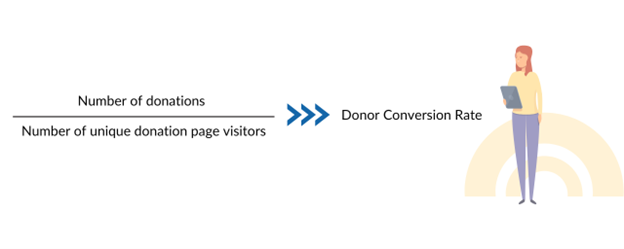47% of Canadians prefer to receive a charitable gift that makes an impact. Is your organization’s website ready to optimize on potential donors this holiday season?
Getting your donors to your website is half the battle; getting them to donate is the next step.
To improve the conversion rate of your donors, in other words, getting people to follow through on donating once they reach your site, it’s crucial to provide an easy & seamless donor experience. Great website experiences are no longer a “nice-to-have” but rather an expectation, as there are many more tech-savvy donors than ever, often accustomed to slick e-commerce experiences and mobile-friendly websites. In fact, 25% of all donations are given through mobile devices. The easier you make donating to your organization, the more people will donate.
Read on to learn some of the best practices you can apply to raise your conversion rate.
Establish your conversion rate benchmarks
First, you’ll want to establish a conversion rate benchmark to track your progress and determine what works for your charity. To do this, simply divide the total donations by the unique number of visitors or pageviews to your charity’s donation page over a period of time.
You can find this information in your Google Analytics or whatever web analytics you use for your charity’s website.
If 1,000 people visit your page in a month, but only 10 donate, you have a conversion rate of 1%.
According to recent research by M+R, the average conversion rate for a charity’s main donation page is 19%. How does your charity measure up? If you’re seeing more than 19%, congratulations, you’re doing better than average. If you’re seeing less, no worries; this is why this article exists. Either way, there is always room for improvement!

The Rule of 3-30-3
Have you ever heard of the 3-30-3 rule? In a digital world where short video content and 280-character tweets are clamouring for everyone’s attention span, the time we have to catch someone’s attention before they move on to the next thing is increasingly short.
The 3-30-3 Rule refers to the 3 seconds we have to catch users’ attention, the 30 seconds we have to engage them and the 3 minutes to gain their trust and convince them to take action.
This means our websites should be intuitive, the most important parts must stand out, and the content should be skimmable. These are the basics to keep in mind as we go into optimizing each part of the donor experience that affects your conversion rate.
- The Ways to Give Page
- The Donation Button
- The Donation Form
Actionable steps to take for your charity
The Ways to Give Page
The first place to look is your Ways to Give page. If you don’t have one yet, creating one is your first step!
1. Check that all your ways to give are listed
Ensure that you have all the types of donations your charity accepts there, from one-off donations to securities or cryptocurrency donations. If you have limited ways to give, it may be time to re-evaluate why you are not accepting those types of donations. CanadaHelps can make it easy for your charity to start a monthly giving program and do the heavy lifting; even if you’re looking to accept less traditional types of donations, it might not be as complicated as you think. You can raise more revenue by providing donors with more ways to give and educating them about the benefits of certain types of giving.
2. Organize the various ways to give by priority to your organization
For most people, it is intuitive to start browsing a page from left to right and from top to bottom. Try organizing the various ways to give by their priority/impact on your organization. You may even wish to highlight your most important campaign “above the fold” (i.e. the part of the webpage your donors see without needing to scroll).
3. Provide a simple description of each way to give
Sometimes, as fundraisers and those passionate and involved in our causes, we can often slip in jargon without even noticing it. Give a short and simple description of each way to give and provide some education on the impact and benefits of different ways of giving. For example, you could tell supporters how monthly donations provide steady revenue so your organization can plan more far-reaching projects and help your donors with strategic giving.
4. Add simple visuals to make the page more appealing
There’s no need to go overboard with too many images on your Ways to Give page, particularly as you may have multiple ways to give. However, adding simple visuals to your page can make it more visually appealing and allow users to skim quickly for the giving option they’re looking for.
The Donation Button
The second place to optimize is your donation button. If you don’t have one already, it’s time to add one.
1. Placing your Donation Button
Figuratively, your donation button should be front and center. However, as internet users, we have become accustomed to certain expectations. The top right is where the most important buttons go on most websites.
Test that the experience works for mobile donors, too. On a mobile view, you’ll want to ensure your donation button is not hidden away in a hamburger or a drop-down menu.
2. Make it Stand Out
Use your “highlight” colour from your branding guidelines. If you don’t have these nailed down yet, use a colour that stands out and ensure it is bright and bold. Network for Good increased the number of visitors who completed a donation by 30% simply by changing their donation button from grey to red!
3. Urgent and action-oriented
What does your donation button currently say? Try experimenting with action-oriented words to create more urgency, such as “Donate Now.”
The Donation Form
Finally, and perhaps most importantly, optimizing your donation form can greatly impact your donor conversion rate. Just as getting a donor to your website is half the battle, having a donation form provider that incorporates these best practices can make following these tips much easier.
1. Keep things clear and simple
Simplicity is key – remove any fields you don’t need from your donation form and keep only what is necessary or information that you will act on. For most donations, you will only require donation details, contact information and payment fields.
2. Demonstrate credibility
Donors trust your charity not only with their gift but also with their personal information and payment information. Ensure that there are indicators on the page and on the form that show the donor that their details are secure. One way to do this is by choosing a donation form provider that has this built into the donation form.
3. Suggested donation amounts
Make things easy for your donors by giving them pre-suggested amounts and connecting them to the impact they will make. For example, $100 can provide food and care for an injured animal for one week.
4. An option for monthly giving
You can also highlight options for monthly giving. Recurring donations can support your charity by providing a steady stream of donation revenue for more far-reaching projects and also help donors give strategically. Some donation form providers may have a way to highlight monthly donations or prompt for monthly donations over a one-off donation as part of the checkout process.
5. Visuals and messaging that match your brand and mission
Branding is not just a nice to have for your donation form. It can give subtle indicators to donors that they are donating to their charity of choice. Emotive imagery and messaging can help them solidify their decision. Try to communicate clearly what their donation will be used for and the impact your charity is already driving.
6. Optimizing for mobile
Don’t forget to optimize for mobile too, with 25% of donors completing their donations through mobile. If a donor cannot easily donate through their mobile, chances are they won’t bother to turn on a desktop to follow through. This is particularly important if you promote your charity on social media such as Facebook or Instagram, as these platforms are primarily accessed through mobile devices.
Conclusion
Increasing your conversion rate can make a huge difference for your charity year-round but also this holiday season. In fact, improving your conversion rates could make a bigger difference for your organization than simply reaching out to more people. Using a great donation form provider can go a long way to upping your conversion rates and, in turn, raising your fundraising revenue.
If you’d like to learn more about CanadaHelps Donation Forms and how we have many of these best practices built into the donation form, please don’t hesitate to reach out to us.
If you’d like to get started with CanadaHelps Donation Forms, register your charity today for free.












